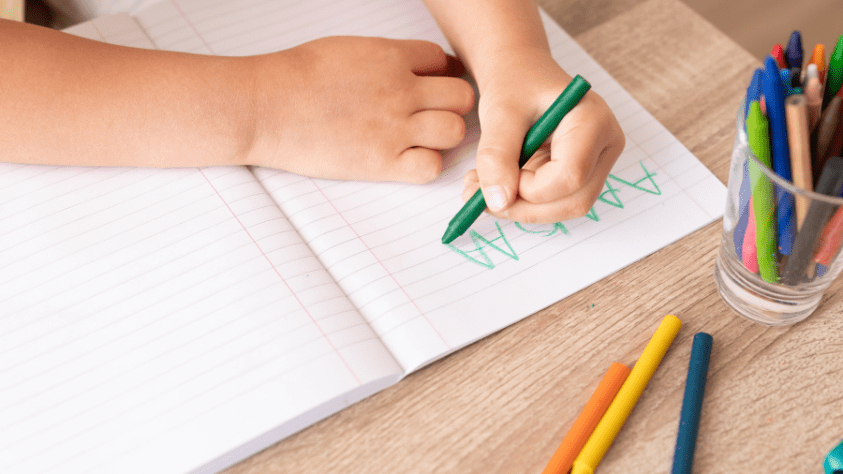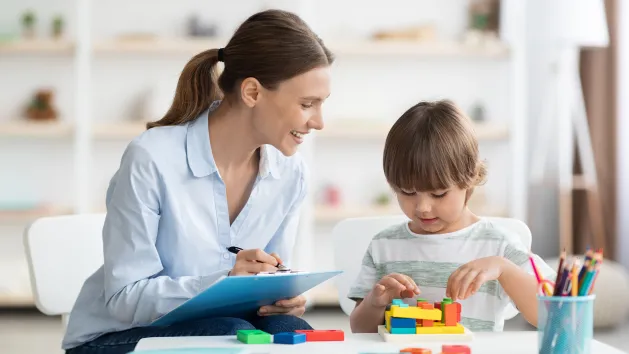
Dyspraxia in children: understanding for better support

Dyspraxia is not an indicator of a child’s intelligence or potential. Rather, it reflects a difference in how the Brain processes motor information.
Dyspraxia disorders in children: what are we talking about?
Dyspraxia, also known as Developmental Coordination Disorder (DCD), can present in different forms, involving disorders of various kinds, among which we can cite the following.
Motor disorders
Dyspraxic children may have problems with both fine and gross motor skills. Fine motor skills concern precise movements such as writing, drawing or buttoning a shirt. Gross motor skills cover more general actions such as running, jumping or throwing a ball.
Visuo-spatial disorders
Dyspraxic children sometimes have difficulty assessing distances, sizes and spaces. This can make tasks such as manual work, catching a moving ball, or even drawing difficult.
School difficulties
Knowing that dyspraxia can turn writing into a difficult mission, its potential impact on school performance is pretty obvious. Teachers and parents need to realize that these difficulties do not reflect the child’s potential, but require an adaptation of teaching methods.
✏ Note : each dyspraxic child is unique. Not all present the same symptoms or difficulties.
Did we know the origins of dyspraxia?
Science has not yet succeeded in demonstrating the exact causes of this neurodevelopmental disorder, whose origin has not really been identified.
Dyspraxia can be developmental but also lesional. Developmental dyspraxia is when there is focal brain dysfunction while all other functions are normal, and lesional dyspraxia when it appears following head trauma, stroke or tumor.
How and by whom is dyspraxia diagnosed?
Detecting the disease: the attending physician or pediatrician can evoke the diagnosis. Dyspraxia is often detected by the school doctor, as the difficulties it causes become more apparent in school activities.
Fine-tuning the diagnosis: the doctor then prescribes an assessment to clarify the diagnosis, in order to establish a care program tailored to the child. This assessment is carried out by a multidisciplinary team including, for example: a pediatrician, psychologist, neurologist, speech therapist, ophthalmologist, occupational therapist or ENT specialist.
Establish a therapeutic project: the examinations carried out as part of the assessment help to clarify the diagnosis with a view to proposing adaptations for the child to live better on a daily basis. These adaptations concern the school sphere but also life at home, and may involve, for example: regular monitoring by a speech therapist and/or occupational therapist, or the use of adapted equipment at school.
Accompanying children on a daily basis
Accompanying a dyspraxic child requires love, patience and kindness. 💖 Every diagnosis is different and so will be the adaptations advised.
Adapting the living environment
An environment with visual cues can help children better understand their space. Use labels, colors or even shapes to help him organize his room or desk. However, these adjustments may not be enough to meet all his needs. Depending on the type of dyspraxia, certain difficulties may persist, such as handwriting. In these cases, the use of a computer for schooling may prove necessary.
The power of play
Gaming is more than just entertainment for children, it’s actually a powerful tool for developing a variety of skills. For dyspraxic children, play is particularly important, allowing them to work on motor difficulties while having fun. Yes, learning can be fun! 😊
Games like Lego, for example, are excellent for working on fine motor skills. They encourage the child to hold, assemble, and adjust small pieces. This type of play also helps develop spatial planning and problem-solving skills.
Board games can help improve concentration and dexterity. They are also an excellent opportunity to develop social skills, such as sharing and waiting one’s turn, which can sometimes be a challenge for dyspraxic children.
Drawing, painting or even clay modeling are fantastic ways to explore and improve fine motor skills. These activities encourage creative expression, which can be very rewarding for a dyspraxic child who finds other areas more difficult. However, note that for children with severe dyspraxia, these types of games can be complex and require additional support.
What about video games?
In the modern world where technology is omnipresent, video games can be a surprising ally in supporting dyspraxic children. No, not all video games are “time wasters”! Some games are even specially designed to stimulate motor skills, attention, and even hand-eye coordination.
Sport and physical activity
Although sport may seem like a challenge, adapted physical activities, such as swimming or cycling with stabilizing wheels, can help work on gross motor skills. Open up a dialogue with your child. Ask them how they’re feeling, what they’re struggling with and how you can help. Every victory, no matter how small, can be celebrated.
The role of school
The French Ministry of Education has set up 4 support programs to meet students’ special educational needs.
The Programme Personnalisé de Réussite Éducative (PPRE) targets students who have not mastered or are at risk of not mastering essential skills and knowledge at the end of the cycle. This program, drawn up with families and the teaching team, sets progress targets over a set period.
Le Plan d’Accompagnement Personnalisé (PAP) is designed for students experiencing persistent academic difficulties due to one or more learning disabilities (such as dyslexia, dysphasia, dyspraxia, ADHD, etc.). It is designed by the educational team in collaboration with the family, and requires the approval of the National Education doctor. It reports on the adaptations planned in the school setting to help the child keep up with his or her schooling.
The Projet Personnalisé de Scolarisation (PPS) concerns students recognized as disabled by the Commission des Droits et de l’Autonomie des Personnes Handicapées (CDAPH) of the Maison Départementale des Personnes Handicapées (MDPH). A referent teacher is responsible for helping to formulate the request and ensuring follow-up.
Le Projet d’Accueil Individualisé (PAI) is designed for students with chronic health problems who are not recognized as disabled. The PAI specifies the necessary school accommodations and details any special treatments and/or diets to be followed.
A pupil suffering from dyspraxia can be supported by a Personalized Support Plan (PAP), designed by the teaching team under the supervision of the Education Nationale doctor.
Hardware adaptations
Using a computer can relieve children for whom handwriting is difficult. Enlarging supports (for example, printed on A3 format instead of A4) and aerating texts can also relieve reading effort. Cloze dictations can ease the writing effort when the target skill is spelling. Finally, allowing extra time for exams or classroom activities can reduce stress and enable children to better demonstrate their skills. All these adaptations can be the subject of a PPRE.
The Babaoo recap
Dyspraxia is a disorder that affects motor coordination. The causes are multifactorial and difficult to identify. Symptoms generally vary from one child to the next, and have a direct impact on daily life and school.
Dyspraxic children can benefit from sympathetic support that values small victories, and from adaptations both at home and at school.
You may also be interested in these articles



